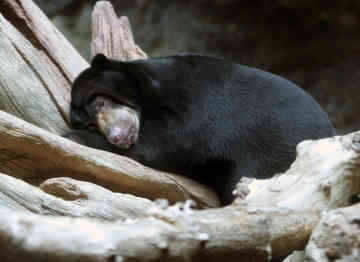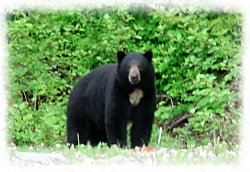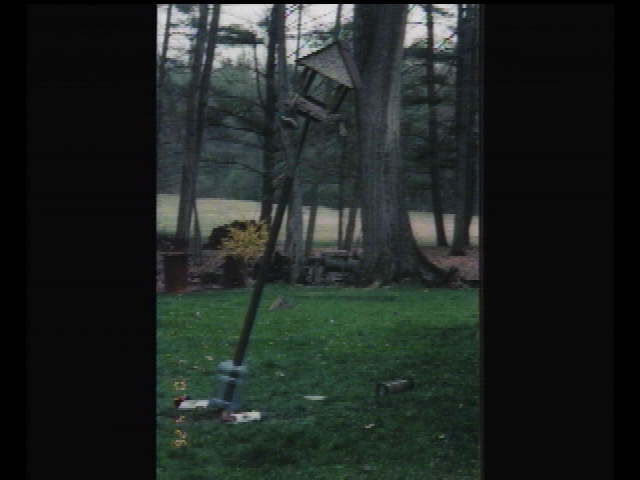 |
March 30th., 2008
Time: 4:00 AM_EST
The black bears have risen from their winter sleep, even though small patches of snow still lay on the ground. Our motion lights came on at 4 A.M. We didn't see which of our bears it was, or if more then one, but they got one suet holder and one feeder off the 10 ft high pole. The picture below is a picture I took last year.
The bear had to have bounced against that pole big time to shake the feeders loose from the hangers. One feeder is destroyed - gggrrrrrrrr. SPRING IS HERE AND THEY ARE BACK.
 |
March 31st 2008 WE NAMED HIM "MR VEE" There have been visits two nights in a row now, which means it is going to be a long long summer. We didn't see the bear the night before, but we did see the one that came here last night. It was one we hadn't seen for better then two years. How could we tell that you ask?
Well when we saw this pair before, there was a mom and a young one who had a white vee patch on it's chest, laying in the yard, eating bird seed. When they started moving around, we saw our first black bear and only black bear we know of in this area, with this marking.

Last night about 10:30, the first bear that showed up had the white Vee patch on the chest. It was bigger of course, my hubby Joe figured it weighed at least 300 pounds. But there are very few bears with that vee pattern around here. Do you think it could have been the poppa bear? HHmmmmm!
Since we can't tell gender of bears, and since this one is traveling alone, we have decided to name this one Mr. Vee.
Later last night, though we didn't see the motion lights come on, being sound asleep, either that same bear came back or there was another one visiting, and pushed over the 10 foot pole and bounced off the last feeder hanging on side of platform.
GGEESHhhhhh! 
This pole is a heavy steel gauge boiler pipe, and cemented in ground. I guess the ground is still too soft from the rains we had, and he or she could push it over.
Notice all the feeders laying on the ground.
It is a sure thing, that we will have to hang ALL feeders in the morning and take ALL feeders down at night. GGrrrrrrr.
And you know what. The feeder that the bear bounced off the pole was a long heavy green steel squirrel proof feeder, with a screw on lid. That bear was smart enough to get that lid off, as it laid right by the feeder. They are extremely intelligent.
My hubby Joe and me spent the morning re-setting the pole, and filling in around the cement with stone, and fixing bird feeders.
 April 4th. 2008
April 4th. 2008
Joe called into work this morning, to see if he should go in to work at the golf course, and was told no, since it rained heavy during the night and will be rainy most of the day. I had gotten up with him and he showed me, that once again our ten foot pole was pushed way over, but with no feeders on it this time, there was no other destruction. Joe no sooner re-set the pole when a flock of wild turkeys came into view in the back field.
There is usually some kind of wildlife visiting that makes life very interesting.
And now that the week-enders and fishermen will be coming and staying in their cabins down along the creek, the wildlife will be checking out their trash cans. So till the next time when something new or different happens, take care and enjoy life around you.
 UH OH! Joe and I went away over the weekend of April 5th and 6th, 2008. We took all the bird feeders and suet down but one feeder. This feeder is twelve feet off the ground, hanging on heavy wire from roof ledge. UH OH! Joe and I went away over the weekend of April 5th and 6th, 2008. We took all the bird feeders and suet down but one feeder. This feeder is twelve feet off the ground, hanging on heavy wire from roof ledge.
When we came home all seemed well, the ten foot pole was NOT pushed over.
Come Monday morning, after Joe had left for work I went about my business of hanging all the other bird feeders back up. While doing this, I noticed my flowers all smooshed that are planted along the side of house and under this feeder we left up. I looked up and the feeder was still hanging so this was good. NO bear can reach it. THey would have to be ten foot tall.
When I was sure the feeder was okay, I looked toward the ground again, and while looking down, there on our pretty gold siding were nice muddy BEAR paw prints. YIKES!! He was a determined bear and now so as not to have them ruin our siding we have to take the feeder down every night when we do all the others. GGGRRrrrrrr.
Till next time --- and that probably won't take long.
 ~ Written By İBarbara L.Chambers Carter aka Bluejay12 ~
Page designed by Bluejay and Diamondavid with much thanks to Leona for finding the background graphics and top picture. ~
April 4th. 2008
Song title: Heartland ~
October 8th., 2009 Sadly I must report that our Mr Vee was shot and killed yesterday, doing what bears do, eating. Unfortunately he was eating an amish farmer's goat. The amish man's son went to a neighbor who came with a 30.06 and killed him.
As was stated in the local daily newspaper,
Mr. Vee was widely known in western Union County, which is where we live,
at the base of Penns Creek Mountain. Blackbears with white markings on chest are rare, and as far as anyone knows this
was the only bear with a vee in the mountains here.
Next month the bears will go into hibernation.
~~~~~~~
Foot note was written by Carl DonahueWild bears can live up to 30 years of age, but typically competition for food and territory is such that their lifespan is much shorter. Weighing less than a pound at birth, the tiny bear cubs grow rapidly, emerging from their dens in March or April weighing as much as 15-20 pounds. 2 or 3 cubs is the normal little for a sow, but sows have been observed with up to 5 or 6 cubs in tow, most likely a result of a natural adoption process. Cubs typically stay with their mother for 3 years, before she drives them away. Black bears come in a wide variety of colors: Jet black to cinnamon, a steel blue (known as Glacier bears), rust and tan colored bears are common as well. A cousin of the black bear is the Kermode, or 'Spirit' bear of the Pacific Northwest. As a result of these color variations, it can often be difficult to distinguish a black bear from a grizzly. Features to look for are the tell tale shoulder hump of the grizzly, his slightly dished, concave face (as opposed to the longer straight or convex snout of the black bear), less prominent ears, and the long claws of the grizzlies' forepaws.
Both grizzly and black bears occupy a wide variety of habitat: dense forest, high mountain alpine and open tundra. Grizzly bears were found on the Great Plains of the American midwest prior to the arrival of European settlers, but have long since been eradicated. Available food source is a driving factor in the size and density of bear populations in the wild. Bears, both black and brown, are omnivores, and eat a large variety of berries, grasses, roots, bulbs, sedges, nuts, acorns, insects (particularly ants), and fish, as well as small mammals such as ground squirrels, and marmots, when available some larger animals.
Bears, both grizzly and black, require a substantial territory to survive, and eradication of their natural habitat by man has been devastating to their populations. Female black bears require an area of 1 to 15 square miles, and the males often have a larger territory where food sources are more plentiful, such as the coastal areas, bear population densities may be as high as one bear per square mile.

Click here for More Real Bear Stories!!
Click Icon for my page listings.

|
|
|